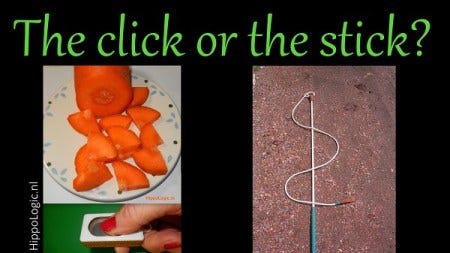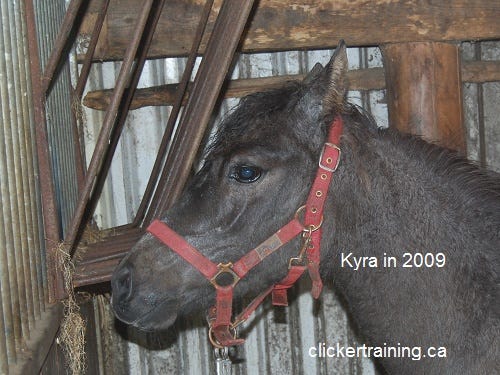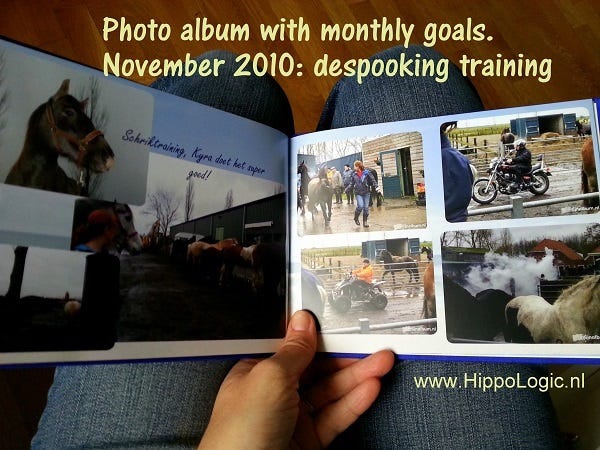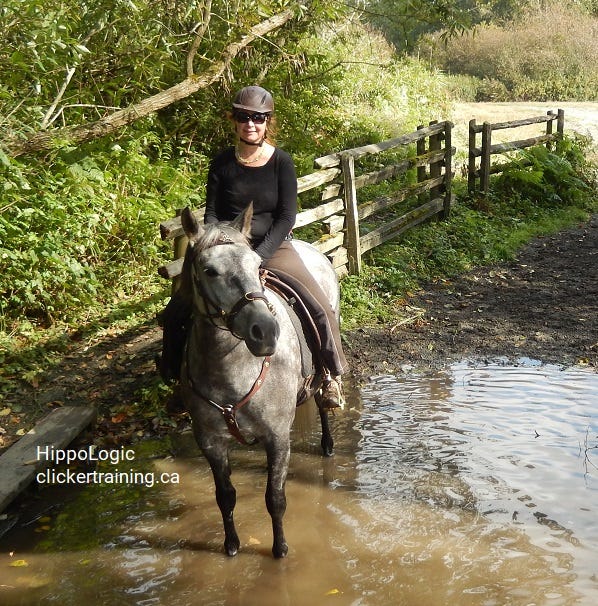Clicker training confused me at first too…
I still remember one of the first times I clicker trained my first pony, Sholto. It was late nineties... Yes, talking about the previous century. :-D
It sounded so simple:
Click = treat.
The horse will do what I want.
Positive reinforcement. Easy, right?
Mistakes happen
But after a few sessions, things got messy.
Sholto got pushy.
He started mugging.
He started throwing in all behaviours he just learned, in the hope of a treat. Even when I didn’t ask the behaviour. It’s dangerous to get Spanish Walk when you lean over to clean his left front hoof!
I thought, “Am I doing this wrong?”
It was frustrating—especially because deep down, I knew there had to be a better way.
A kinder way. A way that felt good for both of us.
Thirty years ago…
It was the late 90s, and clicker training for horses was still virtually unheard of.
No YouTube tutorials. No blogs. No “how-to” guides for using R+ with your horse. Internet was still a baby!
I was lucky, though.
I had a private dressage coach with a scientific background—someone who could actually translate the scientific English jargon into plain Dutch. She was also a life coach and master NLP practitioner. I was so lucky to have Elma!
She was a game-changer.
With that knowledge, I started experimenting.
My results of using R+ and R- training
I learned to implement positive reinforcement horse training (R+) together with Elma, my first mentor. We were both member of a Yahoo email list. Imagine an email discussion with 40 to 50 replies “to everybody” on each topic! Chaos!
All in scientific English, behaviour jargon. I didn’t understand much, but my mentor was could translate all of it into plain Dutch.
I was afraid to ask questions in the group. It seems that so many trainers knew so much. Still, there was no system, no framework to follow. It was all trial and error back in the day. Finding answers in the Yahoo email list.
I used clicker training for ‘fun stuff’: tricks! The serious stuff: NH.
My Natural Horsemanship home study package (also in the nineties) did came with a step-by-step training process. That was a good thing: quick results. The downside: My horse anticipated on the rope halter and “carrot”-stick by walking away from me.
But when I entered the pasture with my bright pink skippy ball, my first target, he came running when I called him!
This video is blurry at best (analoog camcorder), but as you can see: no need to ‘catch my horse’, he started to came running! Just because of clicker training.
What was missing?
About ten years later, I got my first wild horse. Kyra was born in a nature reserve in The Netherlands. She was WILD! She was fearful. She was in survival mode all day long. It was so sad to see her.
Since I was also pregnant at the time (I couldn’t pass up checking of ‘Taming a Wild Horse’ from my bucket list), I was careful. I took precautions: training with protective contact. I wouldn’t use coercion. I didn’t want to risk getting kicked, bitten or ran over. I would see if I could use just positive reinforcement training to tame her!
Since she was my first wild horse, and maybe even the only one ever, I decided to keep track of my training. My first Training Journal was born! An important feedback tool. I started to notice patterns: what worked and what didn’t.
I made videos and photos of all our accomplishments: big and small. I made a photo album of our first 3 years of training!
I noticed that I still had so many questions. I was ‘just doing’ stuff most of the time, following my instincts. I had almost a decade of clicker training experience by then.
I was missing a framework, a system to follow. A step-by-step training method for clicker training horses. A system that the Natural Horsemanship package had offered me.
I started to develop my own step-by-step R+ training framework. The same framework I now teach other horse people! Kyra was my mentor, my student and my guinea pig.
Positive Reinforcement is a Two-Way communication system
🧡 When I started focusing on building a real two-way connection with the horse…
🧡 When I learned how to offer my horse clarity by adding cues to trained behaviours, implementing an End-of-Session signal to tell my horse: “No more treats, the lesson is over'“ and knew how to fade out training tools like clicks, treats and targets…
🧡 When I gave the horse choices and control in training
🧡 When I started to listen and respond to their feedback…
Everything changed.
Suddenly, I had horses who wanted to train.
They felt safe, understood.
They looked to me for guidance—even in stressful situations.
And best of all?
I felt confident again. I wasn’t guessing anymore.
I had developed a system—and it worked.
Are you doing it right?
If you’ve ever felt unsure if you’re “doing it right” with positive reinforcement…
You’re not alone.
That’s what this new series is all about.
I’ll walk you through how to build clarity, confidence, and trust in every session—so you and your horse can actually enjoy training together.
➡️ In the next post:
Why rescue horses thrive on trust, choice, and two-way communication.
You don’t want to miss it.
P.S. Want to get this whole series in your inbox, plus a free (50-minute) 1:1 clicker training assessment with me? Become a paid subscriber!
Happy Horse training! You are the trainer!
Sandra









